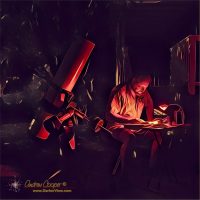Given stay at home orders and a virus haunting our community I have gotten quite a bit of eyepiece time this year. Mostly quick driveway session in the evening, or sometimes the early dawn hours, a solo activity perfect for social distancing.
I usually use my roll-out scope ready in the corner of the garage, a classic 8″ Cave Astrola. Just roll it into the driveway, plug it in using the purpose located power receptacle on the corner of the lanai,. slide an eyepiece in… Ready to go in two minutes.
Last night was a perfect example… It was raining at sunset, but an hour later the skies were clear and dark. Better yet the rain had left clear, haze free air overhead with great transparency. I spent an hour hunting down dark nebulae in Aquila, dark clouds of galactic dust best visible with perfect skies.
The pages of the observing notebook fill quickly, a page or two each evening until the Moon comes back. I have so many object I have never viewed, so many easily visible from the driveway with a fairly small 8″ ‘scope.
Often I come across pleasant surprises, a pretty binary or a deep red carbon star, the region surrounding my target rich with stars and wisps of nebulae, so many wonders I have never seen despite years at the eyepiece.










